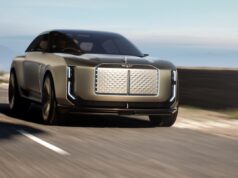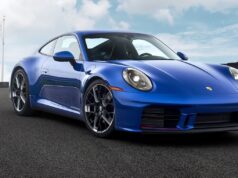
Mercedes-Benz has released full specs and photos of the new 2008 Mercedes-Benz C63 AMG sedan. The car will feature a 6.3L V8 with 451 horsepower and 443 lb-ft of torque.
The C63 will have a top speed of 155mph and a 0-60 time of 4.5 seconds.
Related Stories:
2009 BMW M3 Sedan Spy Photos…It’s Our First M3 Sedan in a Decade!
PRESS RELEASE
THE NEW MERCEDES-BENZ C63 AMG
A C-Class As Never Before
Note: Release includes European specifications
Affalterbach – In the German Touring Car Championships (DTM) the new AMG C-Class ensures exciting motor racing at the highest level, and now its road-going sister model is celebrating its debut: the new C63 AMG. Its AMG 6.3-litre V8 engine develops a peak output of 451-hp and a maximum torque of 443 lb-ft. – unrivalled figures in this segment. Accordingly the C63 AMG accelerates from zero to 62 mph in 4.5 seconds, while its top speed is electronically limited to 155 mph. In conjunction with an all-new front axle, speed-sensitive AMG sports steering and the new, 3-stage ESPÒ, the AMG sports suspension ensures both outstanding driving enjoyment and exemplary handling dynamics. A combination of expressive design, a decidedly sporty interior and a high level of everyday practicality makes the C63 AMG a unique high-performance car. The C63 AMG will make its U.S. retail debut in spring 2008.
With the new C63 AMG, Mercedes-AMG GmbH is making a confident statement to mark the 40th birthday of the company. The new V8 flagship model is now the fifth generation of the AMG C-Class, whose family tree goes back to the C36 AMG of 1993 – the very first vehicle developed as a cooperative venture between Daimler-Benz and AMG.
Merely the appearance of the C63 AMG is impressive enough, with its wide, road-hugging stance. The new hood with its prominent power domes conceals the independently developed AMG 6.3-litre V8 engine, which develops an impressive 451-hp at 6800 rpm from a displacement of 6208 cubic centimeters. In this respect the C63 AMG comes very close to the 464 or so-horsepower delivered by the AMG C-Class racing touring car in the DTM series. This high output also benefits the power-to-weight ratio, which is a very favorable 3.6 kg/hp.
The maximum torque rating of 443 lb-ft. at 5000 rpm is unrivalled in this class, and the torque curve is equally impressive: from 2000 to 6250 rpm the driver always has more than 369 lb-ft. on tap – ideal for powerful acceleration in any engine speed range.
V8 with thoroughbred racing technology and a designer exhaust note
Introduced in 2005, the V8 engine is installed in numerous AMG high-performance cars and excels with its thoroughbred motor sports technology.
Perfect cylinder charging is guaranteed by the vertical arrangement of the intake and exhaust ducts, as well as the magnesium variable intake manifold with two integral throttle flaps. Other high-tech features include variable camshaft adjustment, four-valve technology with bucket-type tappets, a particularly rigid aluminum crankcase of closed-deck design and the low-friction TWAS coating on the cylinder contact surfaces.
Among the particular strengths of the AMG V8 engine are outstanding responsiveness and enormous pulling power – by virtue of its large displacement, it develops over 30 percent more torque than comparable engines in this performance class. Electronically controlled fuel delivery is another reason for the outstanding agility and responsiveness to movements of the accelerator. With its sporty AMG sound, which was designed-in during a series of sophisticated trials, this eight-cylinder powerpack from Affalterbach offers the unique excitement of a fast-revving, naturally aspirated engine – an audible and immediate experience whether at low, medium or high engine speeds.
Key figures for the C63 AMG at a glance:
C63 AMG
Cylinder arrangement/
valves per cylinder: V8/4
Displacement cc: 6208
Bore/stroke mm: 102.2/94.6
Compression ratio: 11.3 : 1
Output hp at rpm: 451 @ 6800
Max. torque Nm at rpm: 443 @ 5000
Acceleration 0-62 mph: 4.5
Top speed mph: 155*
*Electronically governed
In the interests of optimal reliability, the C63 AMG has a particularly efficient water cooling system and large engine and transmission oil coolers. Located behind the large apertures in the AMG front apron, these coolers ensure non-critical operating temperatures at all times – even under the extreme stress of the racetrack.
Like all AMG high-performance engines, the AMG 6.3-litre V8 is built in the AMG engine shop on the traditional “one man, one engine” principle. This means that one technician is responsible for hand-assembling a complete V8 engine to the highest quality standards – which is attested to by his signature on the AMG engine plate.
AMG SPEEDSHIFT PLUS 7G-TRONIC with blipping function
This high-performance eight-cylinder engine has the perfect partner in the form of the AMG SPEEDSHIFT PLUS 7G-TRONIC transmission. Equipped with AMG steering wheel shift paddles and three driving modes, the seven-speed automatic transmission allows a decidedly sporty or more comfort-oriented style of driving according to the driver’s preference. The different modes – “S” (Sport), ” C” (Comfort) and “M” (Manual) differ in their shift characteristics and speed: gearshifts in “S” mode are around 30 percent faster than in “C”, and no less than around 50 percent faster in “M” mode. Pressing a button is sufficient to activate the desired driving program.
The new C63 AMG is the very first AMG car to feature an automatic throttle-blipping function during downshifts. This not only enhances the driver’s emotional experience – the almost completely jolt-free downshifting process also reduces the load-change responses and has a particularly positive effect when braking before bends on the racetrack.
Redesigned Front Axle with 35-millimeter Wider Track
The C63 AMG owes its outstanding handling dynamics to the AMG sports suspension and an all-new three-link front axle design. The stiff configuration of the springs and gas-pressure shock absorbers ensures optimal road contact and low body movements when negotiating serpentine bends at speed. The new front axle has a 35-millimeter wider track – visible by the more widely flared wheel arches – and therefore ensures lower dynamic wheel loads when cornering. A number of features make for substantially more stability and precision in all driving situations: the redesigned wheel location at the front axle is 100 percent more rigid, leading to a considerable improvement in steering precision. Another benefit makes itself felt when braking, as the new wheel location ensures an immediate response even under high dynamic stresses.
In combination with completely newly configured elasto-kinematics, the new wheel location provides greatly improved lateral dynamics and allows the driver of the C63 AMG to benefit from significantly higher cornering speeds. A larger torsion bar stabilizer, new head bearings and dampers with rebound buffer springs further enhance this stability and precision. Steering feedback is also improved by the new kinematics. The speed-sensitive AMG sports steering has a ratio of 13.5:1, but feels more direct as a result of moving what is termed the instant center of motion at the front axle.
The multi-link independent rear suspension has also been thoroughly re-engineered, with a twelve-millimeter wider track and more camber leading to improved cornering performance. Reinforced drive shafts and drive joints increase fatigue strength and round off the improvements to the rear suspension of the C63 AMG.
The completely newly developed AMG sports suspension combines outstanding handling dynamics with the long-distance comfort to be expected of a Mercedes – which also means that the C63 AMG has the characteristic virtues of a genuine AMG.
18-inch AMG light-alloy wheels, 19-inch wheel/tire combination on request
The C63 AMG is appropriately fitted with new, 18-inch AMG light-alloy wheels in a five-spoke design. Painted in titanium grey, these high-sheen wheels in size 8.0 x 18 and 8.5 x 18 are shod with wide-base tires in size 235/40 R 18 (front) and 255/35 R 18 (rear). Even more dynamic handling is made possible by the optionally available 19-inch AMG light-alloy wheels in a multi-spoke design. The front wheels are in size 8.0 x 19 with 235/35 tires, with 9.0 x 19 wheels and 255/30 R 19 tires at the rear.
Generously dimensioned AMG high-performance braking system
Internally ventilated and perforated disc brakes all-round reside behind the spokes of the AMG wheels. The front brakes have size 360 x 36-millimeter discs with six-piston fixed calipers, while deceleration at the rear is by 330 x 26-millimeter discs with four-piston fixed calipers. The AMG high-performance braking system is characterized by great sensitivity and high fade-resistance.
3-stage ESPÒ with Sport function as a new feature in the C63 AMG
The Electronic Stability Program ESPÒ is specifically configured for the dynamic performance of the C63 AMG, which is the first AMG model to feature the 3-stage ESPÒ with a Sport function. This system offers three different control settings, and is a logical further development of the AMG ESPÒ philosophy. The ESP key in the center console enables the driver to choose between three modes – “ESP ON”,
“ESP SPORT” and “ESP OFF” – the currently active mode is shown in the central display of the AMG instrument cluster.
In “ESP ON” mode, the onset of handling instability leads to braking intervention at one or more of the wheels, accompanied by a reduction in engine torque. Briefly pressing the ESP key activates “ESP SPORT”. In this mode the braking intervention to counter oversteer or understeer, as well as the accompanying reduction in engine torque, allows a higher dynamic threshold and, for instance, corresponding drift angles – which means that the driver of the C63 AMG benefits from considerably more active driving pleasure. ESPÒ is restored to its normal function as soon as the brake pedal is operated.
Prolonged pressure on the ESP key activates “ESP OFF”. There is no intervention to control the handling dynamics, and no reduction in engine torque – thus increasing driving enjoyment even further. “ESP OFF” should only be used by experienced drivers on dedicated racetracks. In this mode too, operating the brake pedal restores all the normal functions of ESPÒ.
The system’s traction logic is active in all three ESPÒ modes. If one of the drive wheels threatens to spin, specific brake pressure is applied to create the effect of a mechanical differential lock. This means that the engine power is optimally transferred to the road.
More distinctive exterior design than ever before
It is not only in technological but also in visual terms that the new C63 AMG is more distinctively different from the standard C-Class than ever before. The front end is dominated by the new bonnet with its two pronounced power domes, as well as the trademark AMG radiator grille with a central star and two louvers with chrome inserts. The honeycomb pattern of the grille is also reflected in the large air dams of the new, athletically contoured front apron which forms part of the AMG-specific bodystyling. The fog lamps with chrome surrounds are spaced well apart, acting together with the flared front wheel arches to accentuate the width of the car – with the striking transition from the front apron to the wings leaving a particularly strong impression. The side air vents in the front apron serve to expel the hot air from the oil coolers. If the C63 AMG is specified with the optional bi-xenon headlamps or the Intelligent Light System, the headlamps are also dark-tinted.
Eye-catching features when viewed from the side include the 18-inch AMG light-alloy wheels, the harmoniously integrated “6.3 AMG” lettering on the front wing and the AMG side skirts. At the rear the standard LED rear lights, the AMG rear apron with its black diffuser insert and three pronounced diffuser fins, as well as the AMG sports exhaust system with two chrome twin tailpipes, provide further visual highlights that are hallmarks of the brand. The AMG spoiler lip on the boot lid reduces lift and ensures greater handling stability at high speeds.
AMG interior with new sports seats and performance steering wheel
This decidedly sporty theme is continued in the interior of the C63 AMG, which now has special AMG sports seats with integral head restraints for the first time. The seats not only feature a new design with cross-piping and AMG lettering, but also an adaptive backrest with adjustments for the side bolsters and lumbar support. Perfect handling control is assured with the new AMG performance steering wheel in a three-spoke design, which has a rim diameter of 365 millimeters and a flattened lower section. The upper section is covered in perforated leather, and two silver AMG shift paddles enable the gears to be shifted manually.
AMG main menu with a wide variety of displays
The trademark AMG instrument cluster in a tubular design features newly styled dials, AMG-specific lettering and a new night-time design. Eye-catching details include the 320 km/h speedometer scale, AMG lettering, red needles and the “6.3 V8” logo in the rev counter. The AMG main menu in the central display allows numerous settings, with “Warm Up”, “Set Up” and “RACE” modes activated via buttons on the AMG performance steering wheel. “Warm Up” displays the engine oil and coolant temperature, “Set Up” the current ESPÒ mode and the transmission mode “S”, “C” or “M”. “RACE” mode makes the RACETIMER available, with which the driver is able to measure lap times on a racetrack.
Development and design of the C63 AMG
Creating a new car is a complex undertaking, and this certainly applies to the new Mercedes-Benz C63 AMG whose conceptual phase commenced in 2004. This began with the fundamental feasibility study known as packaging. The new C63 AMG was first constructed as a digital model, the engine, cooling system, fuel system, drive train and axles being “married” with the bodyshell to examine buildability. In spring 2005 the first 1:4-scale design models were produced on the basis of drawings and computer images, and in addition the first testing & development vehicles were already built on the basis of the preceding C 55 AMG. This made it possible to test major assemblies such as the drive train, brakes and axles.
The latest onboard measuring technology provided valuable data such as engine oil, coolant and brake disc temperatures – but other aspects of interest were lap times e.g. on the north loop of the Nürburgring, as well as measurable, precisely defined handling maneuvers to provide comparisons between different axle configurations. These tests were accompanied by extensive aerodynamic tests on the bodyshell of the C63 AMG, and it was only then that the final design was approved.
Following approval of the concept in the autumn of 2005, the first fully-fledged prototypes of the C63 AMG were built. At the same time the high-performance saloon was also produced as a digital prototype. Computer simulations made it possible for the “real” development prototypes to exhibit a very high level of maturity during the first rollout. These simulations included the most important vehicle functions, such as handling dynamics, the engine and drive train, bodyshell durability, suspension performance, passive safety, the engine’s thermal characteristics and performance/fuel consumption.
From Affalterbach to every climatic zone on earth
The standardized and highly sophisticated AMG development and test program for the C63 AMG began in summer 2005. Over the next couple of years around 20 vehicles were dispatched all over the world from Mercedes-AMG GmbH in Affalterbach, to be subjected to strenuous tests in every climatic zone.
Test, analyze and optimize – that is the creed of the specialists at AMG to achieve the objectives laid down in the book of specifications. Another decisive aspect was an ongoing dialogue between Design and Development, so that any necessary technical modifications were also implemented in design terms.
The major test stages at a glance:
Development testing of the engine, transmission and drive train
· Altitude tests in Denver, Colorado (USA), Lesotho (South Africa), Mont Ventoux (France) and Granada (Spain)
· High temperature tests in Death Valley, California (USA), Upington (South Africa), Idiada proving ground (Spain) and Phoenix, Arizona (USA)
· Driving trials in Los Angeles, California (USA)
· Cold temperature tests in Arctic Falls (Sweden)
Development testing of the cooling and fuel systems
· Various driving trials on the high-speed tracks in Nardo (Italy) and Papenburg
· Trials in Upington (South Africa) and Death Valley, California (USA)
· Tests in the DaimlerChrysler wind tunnel
Development testing of the braking and control systems
· Brake testing on the high-speed track in Nardo (Italy) and the Grossglockner Alpine pass (Austria)
· Testing of dynamic control systems on the Idiada proving ground (Spain), in Arjeplog (Sweden) and on the Boxberg proving ground
In addition various endurance trials are run, with the aim of simulating the vehicle’s entire lifecycle under the most severe conditions:
· North loop of the Nürburgring: The car’s drive train, suspension, wheel location system, dynamic control systems, tires and brakes are tested on the world’s most demanding racetrack.
· Long-term testing on different roads: All the components and systems are tested together in everyday operation. Loaded up to their permitted gross vehicle weight, the test cars are put through a precisely defined test program on country roads, motorways and in city traffic.
· Endurance testing on the DaimlerChrysler proving ground in Papenburg: Extreme acceleration and braking manoeuvres with a high proportion of full load operation, making extreme demands on the cooling and fuel delivery systems.
· Endurance testing in the Swabian Alb region: The vehicles are loaded up to their permitted gross vehicle weight and driven on country roads with numerous uphill and downhill gradients, placing extreme loads on the transmission and drive train.
· “Heide” endurance testing: (named after the poor post-war roads across the “Lüneburger Heide”): 2000 kilometers of extreme trials on the test track or on state-of-the-art test rigs. In this case the focus of the developers is on the durability of the drive train components, the entire bodyshell and the integral subframe on which the front axle, steering and engine are mounted. The test cars are loaded up to their permitted gross vehicle weight.
These tests are supplemented with extensive crash simulations and real crash tests, to provide the necessary evidence for country-specific certifications without which no registration would be possible. The end result is final vehicle approval – the green light for the launch of the C63 AMG.
Mercedes-Benz C63 AMG
Engine
No. of cylinders/arrangement: 8/V, 4 valves per cylinder
Displacement cc: 6208
Bore x stroke mm: 102.2 x 94.6
Rated output hp: 451 at 6800 rpm
Rated torque Nm: 443 at 5000 rpm
Compression ratio: 11.3 : 1
AMG SPEEDSHIFT PLUS 7G-TRONIC
7-speed automatic
Ratios
Final drive: 2.85
1st gear: 4.38
2nd gear: 2.86
3rd gear: 1.92
4th gear: 1.37
5th gear: 1.00
6th gear: 0.82
7th gear: 0.73
Reverse: -3.42/-2.23
Running gear
Front axle: Three-link suspension, anti-dive, coil springs, gas-pressure shock absorbers, stabilizer
Rear axle: Multi-link independent suspension, anti-squat and anti-lift, coil springs, gas-pressure shock absorbers, stabilizer
Braking system
Disc brakes all round, internally ventilated and blind-drilled, foot-operated parking brake at rear, ABS, Brake Assist, 3-stage ESP®
Steering
Speed-sensitive rack-and-pinion steering, steering damper
Wheels
Front: 8.0 J x 18; rear: 9.0 J x 18
Tires
Front: 235/40 ZR 18; rear: 255/35 ZR 18
Dimensions and weights
Wheelbase mm: 2765
Track width front/rear mm: 1568/1525
Overall length mm: 4725
Overall width mm: 1795
Overall height mm: 1438
Turning circle m: 10.8
Boot capacity*: 475
Kerb weight acc. to EC kg: 1730
Payload kg: 505
Perm. gross vehicle weight kg: 2200
Tank capacity/reserve l: 66/8
All figures are provisional; * Acc. to VDA measuring method; ** Electronically governed














